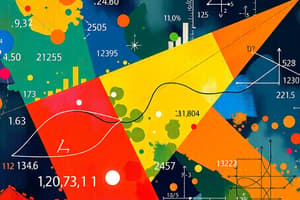Podcast
Questions and Answers
What is the primary purpose of statistics?
What is the primary purpose of statistics?
- To organize data efficiently
- To make inferences and draw conclusions about populations based on samples (correct)
- To create graphical displays of data
- To perform mathematical calculations
Which statistical concept focuses on understanding the typical value of a dataset?
Which statistical concept focuses on understanding the typical value of a dataset?
- Central Tendency (correct)
- Probability
- Graphical displays
- Variability
What does variability (dispersion) in statistics refer to?
What does variability (dispersion) in statistics refer to?
- The process of selecting a sample from the data
- The summary of the data
- How data is spread out (correct)
- The likelihood of an event occurring
In statistics, what is the purpose of graphical displays?
In statistics, what is the purpose of graphical displays?
Why is probability considered essential in statistics?
Why is probability considered essential in statistics?
What is the primary purpose of hypothesis testing in statistics?
What is the primary purpose of hypothesis testing in statistics?
Which mathematical concept involves rewriting a quadratic equation as the product of two binomials?
Which mathematical concept involves rewriting a quadratic equation as the product of two binomials?
In statistics, what does regression analysis primarily focus on?
In statistics, what does regression analysis primarily focus on?
What is the key characteristic of linear equations when represented graphically?
What is the key characteristic of linear equations when represented graphically?
Which concept in algebra focuses on combining like terms or applying order of operations?
Which concept in algebra focuses on combining like terms or applying order of operations?
Flashcards are hidden until you start studying
Study Notes
Math: Exploring Statistics and Algebra
Math isn't just numbers and equations; it's a vast landscape of concepts that helps us understand the world around us. In this article, we'll dive into two core areas of math: statistics and algebra.
Statistics
Statistics is the scientific discipline that concerns the collection, analysis, interpretation, presentation, and organization of data. It's used to make inferences and draw conclusions about populations based on samples. Here are some essential statistical concepts:
-
Central Tendency: Measures that help us understand the typical value of a dataset, such as the mean (average), median, and mode.
-
Variability (Dispersion): Measures that describe how the data is spread out, including the range, interquartile range, and standard deviation.
-
Graphical displays: Visual tools that help us better understand and communicate data, including bar graphs, line graphs, histograms, and scatterplots.
-
Probability: The likelihood of an event occurring, which is essential in statistics for making predictions and estimating the accuracy of data.
-
Sampling: The process of selecting a section of the data (sample) to make inferences about the entire population (sampling distribution).
-
Descriptive statistics: Provide a summary of the data, including central tendency, variability, and graphical displays.
-
Inferential statistics: Use probability theory and mathematical models to make inferences about populations based on the data in a sample.
-
Hypothesis testing: A method to check if there is enough evidence to support a claim about the population.
-
Regression analysis: A statistical method used to find the relationship between variables, such as linear regression, multiple regression, and logistic regression.
-
Correlation and causation: The relationship between two variables, where correlation shows a linear relationship, but does not imply causation.
Algebra
Algebra is the branch of mathematics that focuses on relationships between variables and their properties. It's a fundamental tool for reasoning and problem-solving.
-
Expressions: Mathematical statements that include variables, such as (7x + 5).
-
Equations: Statements that equate two expressions, such as (4x + 3 = 11).
-
Solving equations: The process of finding the value of the variable that satisfies the equation.
-
Simplifying expressions: Combining like terms or applying the order of operations.
-
Variables: Symbols that represent unknown or varying quantities.
-
Linear equations: Equations that can be represented graphically as a straight line.
-
Systems of linear equations: Two or more equations with the same variables.
-
Solving systems of equations: Finding the solution that satisfies all the equations.
-
Solving quadratic equations: Equations of the form (ax^2 + bx + c = 0).
-
Factoring quadratic equations: Rewriting a quadratic equation as the product of two binomials.
-
Applying algebraic concepts: To solve real-world problems involving variables, such as measuring areas or perimeters.
By understanding and applying these concepts in statistics and algebra, you'll be able to make informed decisions, interpret data, and solve complex problems in various areas of life and work.
Studying That Suits You
Use AI to generate personalized quizzes and flashcards to suit your learning preferences.




